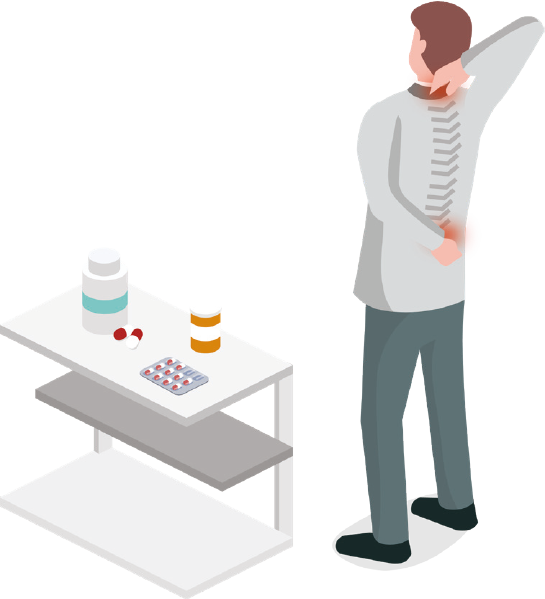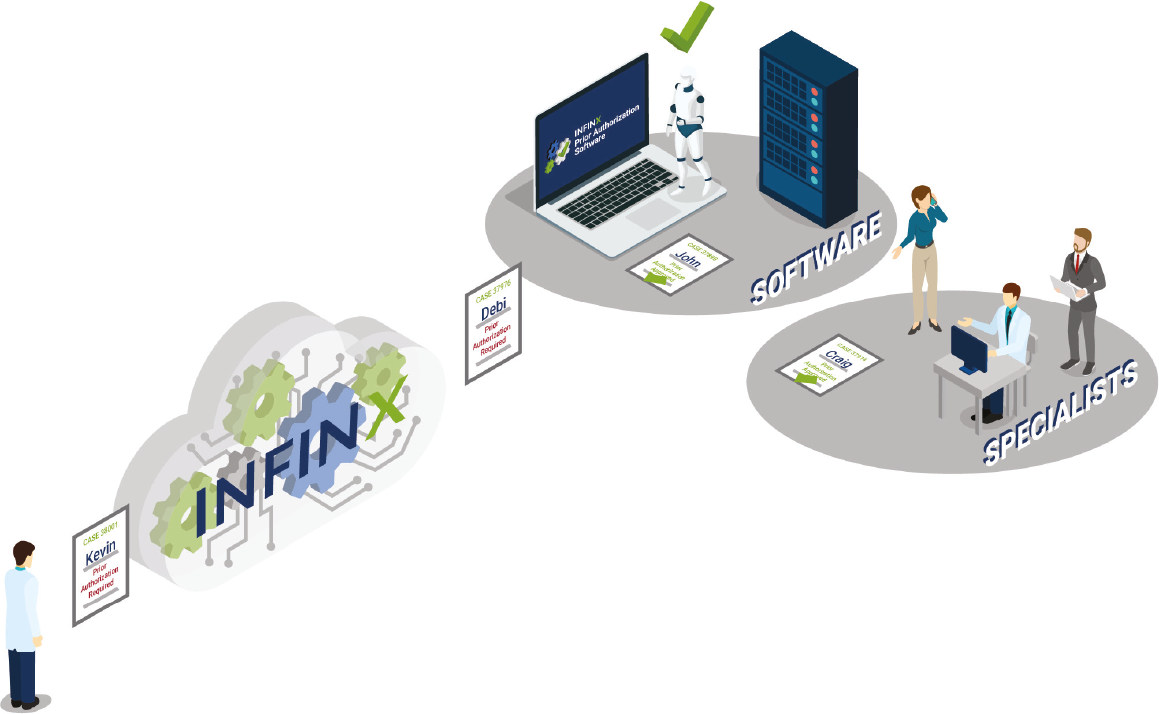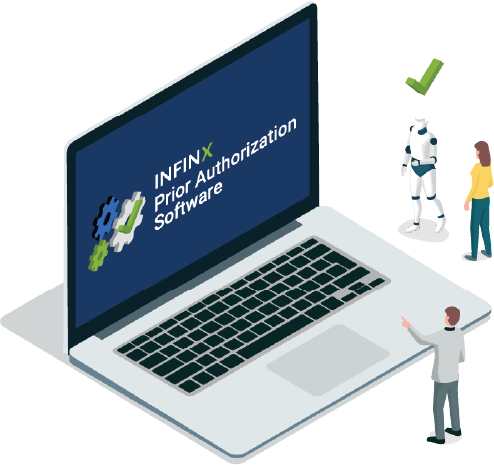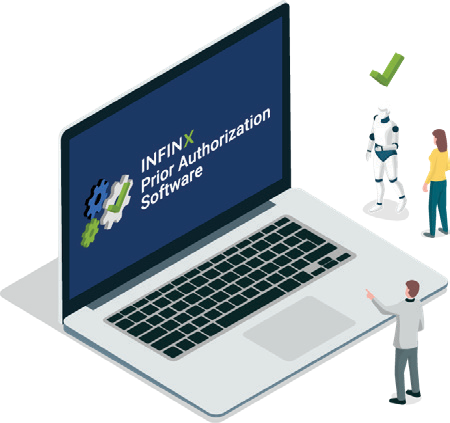White Paper
Using Advanced Automation to Improve Prior Authorizations for Pain Medicine


Executive Summary
With the insurance industry unrelenting on requirements impacting the prior authorization process, pain medicine practices continue to struggle with burdensome and redundant system’s operational implications. With many pain studies and modalities, and numerous medications requiring prior authorization, practices should consider an advanced automation solution that offers real-time processing that can seamlessly integrate with your EHR/EMR. Using advanced automation, artificial intelligence (AI) technology with machine learning capabilities, digital prior authorizations can improve patients’ access to care and relieve clinician frustrations.
Can Prior Authorizations Be Brought Under Control?

It doesn’t matter if you’ve recently completed your pain medicine fellowship or have been a board-certified specialist for many years. Prior authorizations for pain studies, various modalities, and medications, is a necessary frustration that simply can’t be avoided. While the symptoms of pain disorders: chronic and severe pain, fatigue, problems sleeping, depression, trouble concentrating, are undeniable, insurance payers will require providers to document the necessity of treatment before agreeing to reimburse.

Prior authorizations create frustration for pain medicine practices in a variety of ways, including:
• Delaying patient care for up to three or more weeks
• Causing a provider to alter their treatment plan for expediency
• Being more susceptible to review and rejection because of insurance company bias
• Being administratively burdensome, taking several hours to several weeks to complete
• Begatively impacting the scheduling process and, ultimately, the patient experience
Recent Calls for Change
The American Society of Interventional Pain Physicians (ASIPP) recently responded to the Centers for Medicare and Medicaid Services (CMS) call for input re garding prior authorizations, stating their effor ts to increase advocacy and strongly recommended changes that would reduce administr ative burdens placed on their membership.
Additionally, the ASIPP signed onto the American Medical Association (AMA) letter1 expressing strong concerns to the House of Representatives Committee reviewing H.R. 3107, the Improving Seniors’ Timely Access to Care Act2, meant to streamline and standardize the prior authorization pr ocess through Medicare.
While the American Healthcare Insurance Plans (AHIP) group has signed on to support all of the initiatives, insurance payers have been clear that prior authorizations are seen as a useful tool that helps contain costs and manages care being provided.
Consequently, the industry has seen the use of prior authorizat ions increase, not decrease. According to the Medical Group Management Association (MGMA), 90% of healthcare leaders repor t that payer prior authorization require ments are increasing with no end in sight.3
While there has been growing discord about prior authorizations for several years with major governmental and industry-representative bodies joining the chorus, little has changed. E ven if foundational improvements are considered, the prior authorization process will likely continue in a new form, but will still require clinician and administrative time to manage. Being proactive in facilitating an efficient process seems to be the best solution.
Manual Processes Slows Down an Already Cumbersome System
The time involved in processing prior authorizations siphons valuable resources away from where it’s needed while business staff process redundant paperwork, sitting on hold, faxing or re-faxing paper work in hopes of obtaining a quick answer. As documented in the 2019 CA QH Index4, over 87% of healthcare providers use a manual system that is overly burdensome.
Today, prior authorizations are required for many procedures, tests, and medications throughout the healthcare industry — and pain medicine is no different. In-lab pain stud ies, many home studies, and therapeutic medications all need prior authorizations before the pr ovider can begin to treat the patient. By handling the prior authorizations manually, it’s estimated that, on average, over two full days of administrative time per provider is required.
3 Ideas to Make the Prior Authorization Process More Effective
Regardless of the industry stakeholder intention, it doesn ’t appear that prior authorizations will go away completely. Instead it’s more likely that insurance payers reign supreme and will continue in some (hopefully) streamlined form.
No matter how frustrating, prior authorizations do seem to help curb healthcare costs. So the question may be how to make them useful in a pain medicine practice while reducing the administrative burden/costs and improving revenue?
Here are three ways to make the process more functional:

1. Always submit organized, clear documentation — Understanding that insurance will likely question any request for pain studies, expensive treatment, and medication, documentation becomes key, including all provider clinical notes.
Implement a protocol or EHR/EMR template that ensures comprehensive documentation. Understand and stay ahead of what they will request making sure to
fully complete prior authorization paperwork.

2. Be prepared for clinical review on treatment or studies — Most insurance payers will elongate the approval process calling for clinical review or outright reject the request.
Be ready to submit organized, concise, well-articulated appeals with all supporting information. Under the Affordable Care Act, all insurance payers are required to have an appeal process in place. Ask for a 72-hour expedited or urgent review to speed the process along even further.

3. Consider an automated electronic PA process — By engaging an advanced
automation and AI-driven software that is secure, comprehensive, and fully electronic,
prior authorization details can be collected, submitted, and followed-up 24/7 in
real-time.
When using an automated prior authorization system, there is a significant opportunity to reduce administrative time and costs, and schedule patients much more efficiently. A nd should an appeal be needed, an aut omated system would generate and submit the appeal based on pre-defined par ameters with associated documentation.
Improving the Prior Authorizations Process for Pain Medicine
Using a prior authorization software that uses advanced automation and AI technology leveraged with experienced specialists may be the best o verall solution.
To outline, cloud-based and AI-driven software can be integrated bi-directionally with the pain medicine practice’s EHR/EMR and the billing system being used for client management. As soon as the patient’s order is entered into the EMR/EHR, tests, or medications requiring prior authorizations w ould be electronically identified. Also, provider/facility details, patient demographics, and test/diagnosis information would be collected, and an approval request submitted to the insurance payer portal.
AI-driven technology with machine learning capabilities would access continually updated insurance information clearinghouses storing thousands of insurance groups and plans, each with their unique guidelines and requirements and electronically determine the prior authorization parameters for routing the request. Prior authorization appr ovals that once took several days or weeks can now be initiated in real-time with a 98+% accuracy rate, documented in an Infinx case study.5
Let’s take a focused look at the impact aut omated prior authorizations can have in pain medicine:

• Initial Processing — From the moment patient information is entered into the EHR/EMR system, guided processes monitor the key identifiers to initiate the prior authorization with the payer. Matching ordered tests or medications and constantly updating insurance prior authorization requirements, the system stands ready to gather the required information and submit the request in real-time.
Business or clinical staff no longer have to manually process forms, wait on hold, or fax repeatedly and can refocus their time on higher-level functions.

• Continual Follow-Up — Once the prior authorization approval has been submitted, electronic follow up occurs 24/7 until a final resolution is obtained. If additional information is required or an appeal is necessary, the practice is notified immediately so that a response can be crafted and submitted as soon as possible.

• Dashboard Notifications — Waiting for insurance payer responses has historically been a time-consuming affair that took hours of follow-up and burdensome administrative effort.
With an interactive dashboard, today’s AI-driven software gives the practice a snapshot on all active prior authorization case statuses, so patient and clinician questions can be answered immediately, and follow-up can occur as necessary.

• Scheduling — Alleviating the frustrations of scheduling and rescheduling patients based on prior authorizations, a pain medicine practice would have much more accurate parameters to allow a more efficient process for everyone by improving the patient’s experience and enabling providers to focus on their care.

• AR and Claims Management — With less prior authorization problems comes less rejected or denied claims, possibly up to 31% fewer according to MGMA, and more revenue is hitting the bottom line.6 And as a bonus, AI-driven software also available can handle denied claims with a >95% quality standard according to Infinx.

• Analytics and Reporting — Bringing full transparency to future operations, timely analytics, and reporting pinpoint any breakdown inefficiencies or areas needing improvement so that patients receive an overall better experience.
The Overall Cost Savings Available
According to the 2019 CAQH Index, each prior authorization industry-wide costs, on average $14.24 to facilitate manually while using an electronically automated system would cost $1.93 per prior authorization.7 This is a savings of $12.31 per prior authorization and unt old hours of frustration and rework.
In addition, the trickle-down effect would be a reduction in denied or rejected claims, which are currently left unresolved or abandoned with overwhelmed business staff lacking the time or understanding to pursue.
Is This Type of Electronic System Secure?
Using the Infinx Prior Authorization Software platform, a seamless and scalable solutio n is created that uses Health Level 7 (HL7) or Application Program Interface (API) based integration and is compatible with all leading EHR/EMR and pain medicine billing systems. The Infinx Prior Authorization Software platform embeds all Patient Health Information (PHI) in layers of security that is Electr onic Data Interchange (EDI) compliant and stores the data on the cloud using 64-bit and 256-bit encryption that guarantees 100% HIPAA compliance.8, 9

In Summary
As reliance on the field of pain medicine continues to grow, differentiating your practice from others by offering pristine business support to referring providers or self-referral patients helps in securing future potential patient growth. Your referring provider base will see the benefit to their patients with more timely care initiation and less cumbersome reimbursement.
While healthcare associations and government entities continue to discuss streamlining and automating prior authorizations, it seems clear that the process itself is going to remain in place as a way for insurance payers to control care. Meeting the challenge seems a more prudent and proactive response instead of waiting for cange to occur.
About Infinx
Infinx provides innovative and scalable payment lifecycle solutions for healthcare practices. Combining an intelligent, cloud-based platform driven by artificial intelligence and automation, with our trained and certified prior authorization, coding and billing specialists, we help clients realize revenue, enabling them to shift focus from administrative details to billable patient care.
